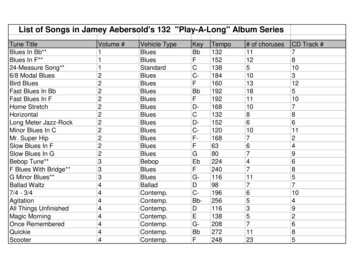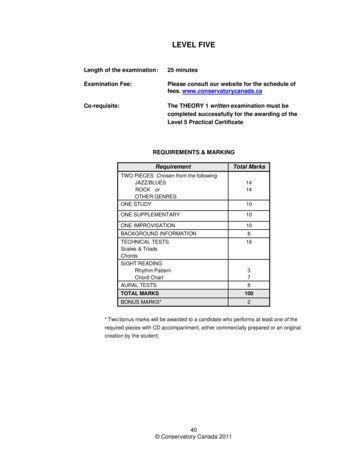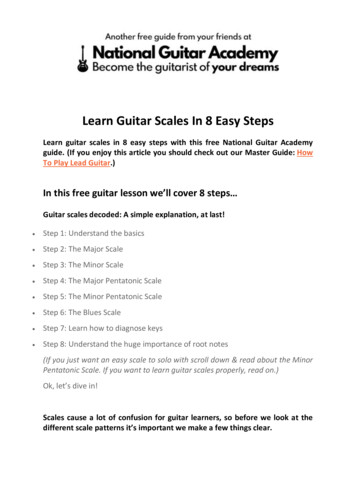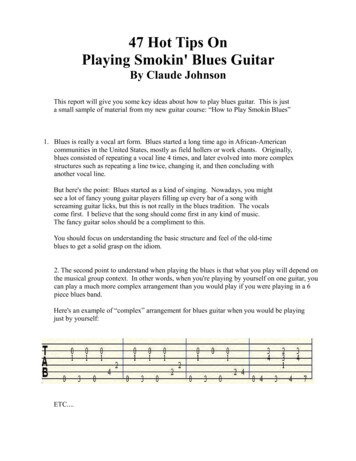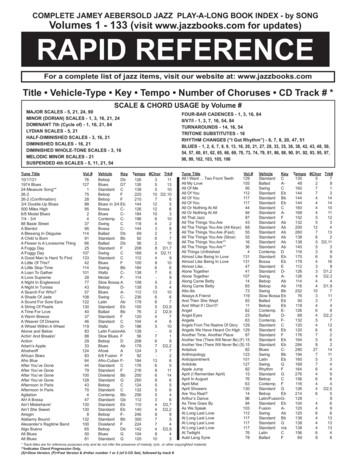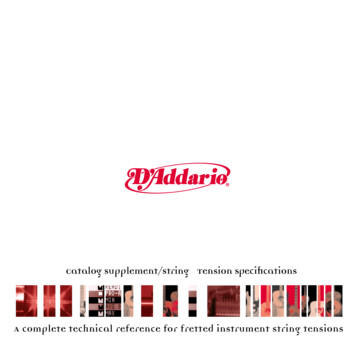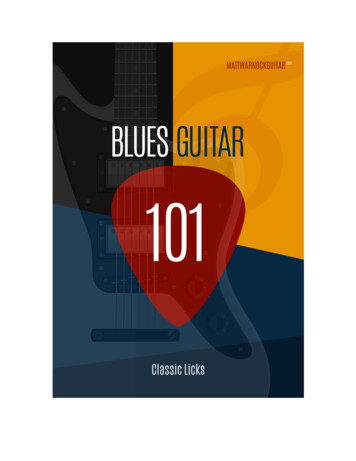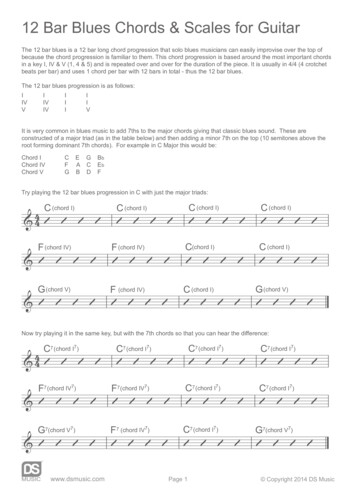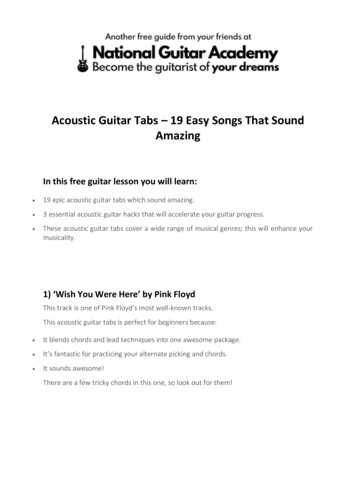
Transcription
www.guitarjamz.com
THE MINOR PENTATONIC SCALEThe Pentatonic scale is one of the most commonly utilized scales in just about all genres of music. Penta, is Latinfor five, much like a penta-gram has five sides, Pentatonic scales are constructed from five notes. The MinorPentatonic scale is constructed from five notes from the Natural Minor Scale, also called the Aeolian mode. TherdthMinor Pentatonic scale is built from the five scale degrees of root, b3 , 4 , 5th, and b7th. The scale illustratedbelow is what many call the basic “box” position and has its low root played with the first finger on the low E string.The root notes are illustrated with black circles and the numbers inside the circles indicate the fingering to beutilized when playing this scale. It’s important to learn this basic scale first, as we are going to build upon thisscale in coming lessons and eventually you will need to learn this scale in all positions all over the neck and in allkeys. Many other scale shapes and scale connecting links are diagrammed out in the coming pages.Minor Pentatonic Scale Basic Box1131311The key signature is determined by which root note is played. Forexample if you play this scale starting at the fifth fret on the low Estring it is an A Minor Pentatonic scale consisting of the five notes A,thC, D, E, and G. If you were to play this scale on the 8 fret it wouldbe a C Minor Pentatonic scale consisting of the five notes C, Eb, F,G, and Bb.344 root notes1#Take your time and play the scale slow and in time, speed will come.Practice the scale utilizing the fingerings illustrated. Sound each noteclean, with no string buzzes or overtones. As you move through thescale make a mental note of when you hit the three root notes,(illustrated with the black circles).Fingering tobe utilized4Much like moveable bar chords this scale can be moved up anddown the guitar neck and the root note will determine the key you areplaying. Practice the scale in all keys.This scale will form the building block of many concepts to come.You want to be very familiar with this scale pattern, but do not rely onit exclusively. We are going to build on this scale extensively. Soonwe will be spicing it up and expanding it, making it a more fluidsounding scale that you can move laterally across the neck and notlimited to box to box type lead playing.Hip string bends when utilizing the above Minor Pentatonic scale: – bending strings is one of the most expressive things youcan do on the guitar. You will want to get very proficient and exact with string bending, it’s an art. Always bend to a target note.When bending strings it is imperative that you are bending the notes in pitch. You don’t want to over bend or under bendnotes, as they will then sound sharp or flat. Practice bending strings and then check the pitch by sounding the note you areattempting to bend to, your target note. This is a good self-check to ensure you are bending in pitch. Also practice stringbending by plugging directly into an electronic tuner and watch the needle as you bend a note. See the progress as you bendthe note and ultimately hit pitch. Keep doing it over and over till you feel the bend strength wise, and hear the bend in pitch.For purposes of this string bending exercise play the scale with a fifth fret root or A Minor Pentatonic scale, but once learned,practice the bends and scale in all keys.th1. Bend the b7th a whole step up to the root. Bend the G note at the 8 fret of the B string up one whole step to the A rootthnote. You can also bend the same note an octave lower at the G note at the 5 fret on the D string up one whole step.thth2. Bend the 4 a half step to the blue note - bend the D note on the 7 fret of the G string up one half step to the Eb note.thth3. Bend the 4 degree a whole step to the fifth - bend the D note on the 7 fret of the G string up one whole step to the E note.thThe 4 or D note can be bent either a whole or a half step, try both.thth4. Bend the b3rd a full step to the 4 – bend the C note at the 8 fret of the high E string one whole step to the D note.thth5. Try a unison bend. Utilize your 4 finger to bend the G note on the 8 fret of the B string a whole step to an A note whilethplaying the A note at the 5 fret of the high E string with your 1st finger.th6. Unison bend – Utilize your 3rd finger to bend the D note on the 7 fret of the G string a whole step to an E note whilethstplaying the E note at the 5 fret of the B string with your 1 finger.rdth7. Double stop bend – bend two strings a half step each with your 3 finger. Bend the D note at the 7 fret of the G string onethhalf step while also bending the F# note at the 7 fret of the B string one half step.rdth8. Double stop bend – with your 3 finger bend the D note at the 7 fret of the G string a whole step while playing the G notethon the B string with your 4 finger.rdrd9. b3rd to major 3 bend – bend the b3rd or C notes a quarter to a half step to the major 3 . This is a very cool bend as therdb3rd is a very ambiguous note in this scale. It sometimes will sound great as the b3rd but also as a major 3 like when playingthover a 7 chord. So this note has some play in it and you don’t have to be exact with the bend – play with it and you will soonbe utilizing it all the time. Bend the note slow and put a hook on the end of it.Copyright GuitarJamz Inc. - All rights reserved – unauthorized duplication or distribution of any part of this book is prohibited
THE MINOR PENTATONIC EXPANDED I SCALELet’s build on the minor pentatonic basic box shape scale that you learned in the previous page. We are nowgoing to expand the scale two frets in each direction combining three of the box shapes, (all five box shapes arediagrammed out on page 12). We are still going to play the same five-note scale. However, the expanded scaleexudes a much more fluid sound and sets up many additional and different combination runs and licks than juststaying solely in the basic “box” shape. You certainly want to have all the pentatonic scales in the box patterns inyour arsenal, but this expanded scale you will find really opens the pathways and lead guitar avenues a lotfurther. Commit it to memory and practice it in all keys. You will find yourself using these expanded scales all thetime when playing in the pentatonics – they are invaluable.Expanded I Minor Pentatonic ScaleAnalyzing this expanded scale you can see part of the basic boxpattern you learned in the previous page encapsulated in themiddle of the shape. The shape is expanded two frets in eachdirection using the neighboring two boxes. Now you have aPentatonic shape that doubles the fret span of the basic boxpattern.11331133311As always when learning a new scale, take your time and play thescale slow and in time. Sound each note clean, with no stringbuzzes or overtones. As you move through the scale make amental note of when you hit the three root notes, (illustrated withthe black circles). Practice the scale utilizing the fingeringsillustrated. Notice the shift in fingering when you get to the Gstring. There is a one – three – two finger combination. Utilizeyour second finger when playing the third note on the G-string asthat will set you up for the two and three note combinations andlicks to be played with the G, B, and high E strings. As always,you want to utilize the proper fingerings that set you up for thenext lick, run, or chord.233Much like the first pentatonic scale in the basic box pattern thekey signature for the expanded scale is determined by which rootthnote is played on the 6 string. Play that note with your thirdfinger. For example if you play this shape starting at the fifth freton the low E string it is the Expanded I A minor pentatonic scaleconsisting of the five notes A, C, D, E, and G. If you were to playrdththis scale starting with your 3 finger on the 10 fret it would bethe Expanded I D minor pentatonic scale consisting of the fivenotes D, F, G, A, and C. Practice this scale in all keys up anddown the fret board.For the G string pivot with your second finger for the 1,3,2 fingering combinationKEY POINT: You can grab these above two scales fast if you memorize the two above scales as:1.2.stBasic Box Position Minor Pentatonic Scale – 1 finger root on the low E stringrdExpanded I Minor Pentatonic Scale – 3 finger root on the low E stringCopyright GuitarJamz Inc. - All rights reserved – unauthorized duplication or distribution of any part of this book is prohibited
THE MINOR PENTATONIC EXPANDED II SCALENow that you are familiar with the Minor Pentatonic scale in the basic box position and in Expanded I form, letsthlearn the Minor Pentatonic Expanded II scale. This scale will have its root note on the 5 or A string and you canrdstart with your 3 finger. Illustrated below is the Expanded II Minor Pentatonic scale. With both Expanded scalesand the basic “box” shape you can cover just about the entire fretboard. Practice these scales in all keys up anddown the fret board. Commit them to memory, as you will find yourself grabbing them all the time.Take your time when first learning this scale pattern, and playthe scale slow and in time. Sound each note clean, with nostring buzzes or overtones. As you move through the scalemake a mental note of when you hit the three root notes,(illustrated with the three black circles). Practice the scaleutilizing the fingerings illustrated and work up this expandedscale in all keys. Just use the first and third fingers to play theentire scale.Expanded II Minor Pentatonic Scale111333In this Expanded 2 scale the key signature is determined bythwhich root note is played with the third finger on the on the 5or A string. That is how you can find all the different scalesquickly, by identifying the root notes. For example if you playthis shape starting at the tenth fret on the low E string it is theExpanded II A Minor Pentatonic scale consisting of the fivenotes A, C, D, E, and G. This is due to the root note beingthplayed on the 12 fret of the A string – an “A” note. If you werethto start this scale on the 12 fret of the low E string it would bethe Expanded II B Minor Pentatonic scale.11333133KEY POINT: You can grab the above scales fast if you memorize the three above scales as:1.2.3.stBox Position Minor Pentatonic Scale – 1 finger root on the low E stringrdExpanded I Minor Pentatonic Scale – 3 finger root on the low E stringrdExpanded II Minor Pentatonic Scale – 3 finger root on the A stringCopyright GuitarJamz Inc. - All rights reserved – unauthorized duplication or distribution of any part of this book is prohibited
THE MINOR PENTATONIC SCALE – the 5 box scalesIllustrated below are five common box shapes for the Minor Pentatonic scale. I usually find myself playing theexpanded I and expanded II scales more often, but you should know all 5 box positions so you can utilize theentire neck. Practice these in all keys and remember to make mental notes where the root notes lie. Start learningthe scales below in the key of Am as they line up across the fretboard nicely and you can start the number 1 boxthwith your 4th finger on the 5 fret of the Low E string on the A note.Commit all the shapes and notes to memory and you will soon be gliding across the neck in Pentatonic heaven.Remember, it is critical to memorize what notes you are playing, not just the shapes. You want to be able to pickout and land on any given note depending on what chord changes you are playing over. Too many timesguitarists just memorize shapes and forget what notes they are actually playing. So spend time learning the notesin all keys and you will benefit greatly with this extra work. These box shapes will give you many different riff ideasand runs. You will find them to be quite useful. Remember to practice and learn these scales in all keys andpractice linking them together. Soon you will be able to see the entire fretboard mapped out as one large scalethat travels up and down the entire neck.th#1 box – in Am start with 4thfinger on the 5 fret, low E stringon the A note.2#3 box – in Am start with 2thfinger on the 8 fret, low E stringon the C note. (these first threeshape)boxes make the Expanded 1)11122114441111244112334nd#2 box – in Am start with 1stthfinger on the 5 fret, low E stringon the A note. (the basic box344444st#5 box – in Am start with 1 fingerthon the 12 fret, low E string on the Enote. (these last two boxes and the first#4 box – in Am start with 1thfinger on the 10 fret, low E stringon the D note.one combine to form the Expanded 2shape)11111111334113123324434st2443444Copyright GuitarJamz Inc. - All rights reserved – unauthorized duplication or distribution of any part of this book is prohibited
THE MINOR PENTATONIC BLUES SCALEthThe Blues scale is basically the Minor Pentatonic scale, with one added note, the flatted 5 , or blue note. The b5creates a certain amount of color and tension that is extremely useful. The blues scale is not solely utilized inblues music but rather is used in many musical genres including rock, country, jazz, pop, metal, punk, and more.Adding this scale to your lead guitar arsenal will definitely add a little “bluesy” color and texture to your playing.Use it pretty much whenever you play Minor Pentatonic scales. Now we will make it the Minor Pentatonic BluesScale. This is the scale when you hear the term “blues scale” tossed around.rdthBy adding the b5 note we now get the six-note scale constructed from the degrees of 1, b3 , 4 , b5th, 5th, andb7th. The first illustration below on the left is the basic box shape Minor Pentatonic scale. Directly below that weadd the b5th and now have the Minor Pentatonic blues scale. They only differ by one note, the b5th or blue note,illustrated in blue. The illustration below to the right is the Expanded I Minor Pentatonic Blues scale.A common challenge with many students is that they always play and think of scales in box patterns and they stayin one box, then stop, move to the next box, then stop, and so on. This can have a real boxy and fragmentedsound with lines that have no continuity. Students benefit greatly by learning to play ACROSS the neck by playinglaterally. The ultimate goal is to see the entire neck as one big inter-connected scale. Then leave them allconnected and just move the whole chunk back and forth as one chunk, to change key. These expanded scaleswill pull you out of the traditional boxes that can have a boxy sound that many players cant seem to leave behind.As always, utilize consistent fingering and practice these scales in all keys and learn all the scales up and downthe neck. Then apply them by practicing your soloing over the jam tracks. Make strong solo statements byemphasizing strong chord tones and root notes. Employ good phrasing and continuity, and play laterally acrossthe neck. Rock on!Basic Box Minor Pentatonic Scale1111333144Expanded I Minor Pentatonic Blues Scale14113111332311133Minor Pentatonic Blues Scale2111111243433444When ascending the scale at the G-string pivot withstyour 1 finger playing 1,3 then 1,2. Then descendinguse a 3,2,1,1 finger combination on the G string root note blue note (b5)Copyright GuitarJamz Inc. - All rights reserved – unauthorized duplication or distribution of any part of this book is prohibited
THE MINOR PENTATONIC BLUES EXPANDED II SCALELet’s continue to add the b5th, or blue note, to the Minor Pentatonic scale in the Expanded II scale. Below on theleft is the Expanded II Minor Pentatonic scale. By adding the blue note we now get the Expanded II MinorPentatonic Blues scale, as shown below on the right. There is only one note added to make the Blues scale.Examine the fingering carefully as it varies slightly between the two scales. The fingering shown below puts yourfingers in the proper place on the fretboard to set up for the next part of the scale, or if playing a solo, the nextlick. Remember it is crucial to always have your fingers in the right position, setting yourself up for the next lick orrun. Practice the scales below in all keys.When playing through these scales remember to make mental notes when hitting the root notes and the bluenotes, as you may want to emphasize these notes in your lead lines - its all about emphasis! Also remember, as Ialways state, just don’t memorize the fingering for scales or just the scale shapes. Take the extra time to learn thenotes and intervals that you are playing in a given key. Taking a little extra time to do this will make you a muchbetter musician in the long run.Expanded II Minor Pentatonic Scale11Expanded II Minor Pentatonic Blues Scale1111312333312133331113112333Copyright GuitarJamz Inc. - All rights reserved – unauthorized duplication or distribution of any part of this book is prohibited3
THE MINOR PENTATONIC BLUES SCALE – ALL FIVE BLOCK SCALESBelow are the five box shape Minor Pentatonic Blues scales. This now completes the entire neck in MinorPentatonic Blues scales. All the holes and gaps are now filled and you want to work towards playing the MinorPentatonic Blues scale over the entire neck. Practice the Blues scales in all keys and try and connect them withthe rest of the shapes so you can play up and down the entire neck. Connect them in with the Expanded I and IIBlues scales. Remember, try to see the connection points and the neck as one big scale and play laterally acrossit – not always just as all individual boxes.th#1 box – in Am start with 4 fingerthon the 5 fret, low E string on the Anote. Go outside for the blue note onthe D string1122224413311133344444st#5 box – in Am start with 1 finger onth12 fret, low E string on E note. (last twoboxes and the first one combine to formexpanded II scale)11123141324st11134#4 box – in Am start with 1 finger onththe 10 fret, low E string on the Dnote. First three strings are first partof expanded II scale31244411234111nd#3 box – in Am start with 2 fingerthon the 8 fret, low E string on the Cnote. (the lower part of this box isthat mini box in the expanded I scale)#2 “basic box” shape – in Am startthwith 1st finger on the 5 fret, low Endthstring on the A note. Use 2 and 4fingers for blue notes411123341441113344Copyright GuitarJamz Inc. - All rights reserved – unauthorized duplication or distribution of any part of this book is prohibited
SPICING UP THE MINOR PENTATONIC BLUES SCALENow that you have learned some Pentatonic scales lets look at how we can spice things up a bit to add somemore color and texture to your playing. Its not enough just to know the scale but you will need to take the notesand do musically interesting things with them. Think of guitar playing as speaking a language. We are going toturn our notes, or words, into sentences. This is what some refer to as phrasing - the way we connect and playour thoughts musically on the guitar. What’s so important in great lead playing and improvisation is engaging youraudience and drawing them into your playing. You want to speak to your audience musically in a way that isengaging and that they can comprehend. So it’s so important that your musical thoughts and phrases makemusical “sense”. For instructional purposes we are going to use the Minor Pentatonic basic box shape to illustratethese techniques. In the illustration below the black ovals are the root notes, the white ovals are the other notes inthe scale, and the colored ovals are the various notes we will discuss below.1. Spice it up by doubling and tripling up on your notes. Don’t always go from one note to the next to the next instraight eighth or quarter notes. You have to bust them up a bit to make them sound more interesting. Play thesame note in rhythmic combinations. Ba.Ba.Ba Ba Bow – remember, if you can say it, you can play it! Feel therhythm of the line, don’t just play it straight – and say the phrase out loud if you need to. Then change around therhythm. Get into an idea that you like and keep repeating it, perhaps playing it a little different rhythmically eachtime. Learn a rhythm or rhythmic phrase and then apply it to some of your favorite licks across all the strings. Sowhen you are noodling around and get into a little cool idea – keep it – keep playing it – turn the rhythm aroundand exploit it and keep repeating the phrase. Remember rhythm, repetition, and melody are the keys!2. Spice it up by slurring your notes with passing tones. Slide into your notesutilizing half steps passing tones. It is a great sound as you get the inference of thepassing tone and then the target note. Do not hang on passing tones and don’t tryand bend or vibrato them – get on and off them quickly, just use them in passing.Bookend your passing tones with two strong scalar notes. For example, if you areplaying a five-note Pentatonic scale, you can utilize the other seven notes aspassing tones. Just remember to get and off them quickly and bookend them withstrong notes that are in the scale. Try utilizing the passing tones in the diagram tothe right. Slide from any note in red to the scale note one half step higher. Thenote in blue is the blue note, or b5, and makes a great note to use as a passingslide tone also. Double and triple up on these slides. These slurs will add somegreat color and interest to your playing.3. Spice it up by adding the ninth scale degree to the Minor Pentatonic scale, (the ninth is illustrated above as theorange oval). This note sounds great and will work most of the time when using minor pentatonic adding muchcolor to the scale. It is a great note to slide off, bend a half step, use in triplet patterns, and use in pull off andhammer licks. The outside sounding note will give you a little jazzy sound. So bend it a half step or slide from thethninth to the next note, the b3rd. It’s a great sounding note! Also use the 9 on the G string – more cool licks!4. Spice it up by slightly bending the b3rd on the G-string, (the b3rd is a white oval with an asterisk, “*”). The b3rdis a very ambiguous note, especially when playing the blues. It sometimes sounds best when played as a naturaltone and sometimes sounds great bent up a quarter or half step depending on what chord its being played over orthat you go to next in the progression. Pull that b3rd note down in a nice bend and really feel it. Slur in and out ofit and you will find it will add a lot of texture to your playing. If you are playing in the box shape it is one of the fewtimes where I like to bend with my first finger. It’s an easy bend as you are only going up a quarter or half step soyou don’t need multiple finger strength to reach and hold the pitch. You can bend it slow or fast, but put a lot offeeling and passion into this bend and you will absolutely love the sound! One of the few bends where you havesome leeway and don’t have to bend it exactly perfect – anywhere in that quarter to half step range sounds great.5. Spice it up with reverse slides – instead of always sliding a note up the fretboard try sliding down the fretboard.A real nice reverse slide is to slide the blue note one-half step back to the fourth. In the diagram above reverseslide from the blue oval with the asterisk back one half step. Really feel the slide and hear both notes. Repeat theslide two or three times in succession for a real cool riff. So try sliding in both directions not just limiting yourself tosliding up the neck.Copyright GuitarJamz Inc. - All rights reserved – unauthorized duplication or distribution of any part of this book is prohibited
THE MAJOR PENTATONIC SCALEThe Major Pentatonic scale is a five-note scale consisting of five notes from the Major scale. It is an extremely useful scalethat has a very sweet major sound. At times full major scales may be inappropriate to play over a given progression, as theymay sound a bit stiff. The major seventh note is a very “ify” note, especially in rock music as sometimes it works and manytimes it doesn’t. Defaulting to the Major Pentatonic scale for that major sound in many of these instances is a great idea andwill give you a killer sound. You hear the major pentatonic scale used often in blues music.The five-note Major Pentatonic scale is derived from five notes from the Major scale similar to how the Minor Pentatonic scaleis derived from five notes from the Natural Minor scale. The intervals of the Major Pentatonic are 1,2,3,5,6. You do not play thethth4 and 7 degrees of the Major scale.For many guitarists there's confusion surrounding the Major Pentatonic and it's relative minor, the Minor Pentatonic scale. TheMinor Pentatonic is the relative minor of the Major Pentatonic and lives a minor 3rd, or three frets away, below the MajorPentatonic. For every major key there is a relative minor key. Both keys will have exactly the same notes. Refer to the handouton the circle of fifths on page 31 for a complete listing of every major key and its relative minor key.Illustrated below is the “basic box shape” C Major Pentatonic and its relative minor, A Minor Pentatonic. C Major Pentatonicscales can also be viewed as A Minor Pentatonic scales. Both scales consist of the same notes C, D, E, G, and A. Yourstarting and emphasis notes determine which scale will sound. The confusion often comes because of the multiple names. CMajor Pentatonic and A Minor Pentatonic are the same scale, just different starting and emphasis notes. Just like when playingutilizing the modes, it all comes down to what notes you are emphasizing - emphasis is so important!Play both scales starting and ending with the root and listen to how the Pentatonic Major sounds very sweet and majorsounding when staring on and emphasizing the C notes. Play the same shape but start and end on the A notes. Now you getthe darker bluesy Minor Pentatonic scale. Same notes, just different start and emphasis points. One scale gives you thehappy, major, Allman Brothers/BB King type of sound while the other gives you a darker, bluesy, minor type sounds.Remember that you can get to all the Major Pentatonics by going through the relative Minor Pentatonic scales. So you don’thave to learn any new shapes for Major Pentatonic if you already know your Minor Pentatonic scales. Just flip them to theirrelative Major Pentatonic.A Minor Pentatonic Basic Boxth5 fret1411133314C Major Pentatonic Basic Box14th5 fret41113331144If you know your Minor Pentatonic scales across the entire fretboard there is no need to learn any new shapes to play MajorPentatonic. You can get to those shapes from the relative minor Pentatonics. Learning more shapes would be redundant.The blue note does not always apply to Major Pentatonic and often will not sound very good. So use the straight MinorPentatonic scales and Expanded scales without the blue notes. There is not as much room for error soloing in major key either- bad notes really stick out. You also can’t slur all those passing notes like we discussed when using Minor Pentatonic. So becareful with your note choices and let your ear help to guide you. So think of it like you have a bit more leeway in MinorPentatonic than you have in Major Pentatonic.For that sweet Major Pentatonic sound utilize all of your Minor Pentatonic shapes focused on emphasizing the root of themode – the major. For example, when playing in C Major Pentatonic think of the relative minor, A Minor Pentatonic shapesthat you have learned previously. Just start and emphasize on the C notes, not the A notes. You want to sound major so youhave to emphasize the major root notes, not the minor ones. Practice in all keys and all positions up and down the neck.Copyright GuitarJamz Inc. - All rights reserved – unauthorized duplication or distribution of any part of this book is prohibited
Major Pentatonic Sus4 ScalesA very cool way to spice up the Major Pentatonic scale is to add the fourth degree to the scale. Instead of it beinga five-note scale it will now be a six-note scale. Adding the fourth degree makes it a Major Pentatonic Sus4thscale. The intervals of the scale are now 1, 2, 3, 4, 5, and 6. Basically it’s a major scale with the 7 degree leftout. This scale works just about every time so try using it when playing in Major Pentatonic.thIn the past lesson we discussed that the major 7 is a very “ify” note. This is true especially in rock music assometimes it works and sometimes it doesn’t depending on the underlying chords. What is great about the MajorthPentatonic Sus4 scale is that it leaves that major 7 note out all together. This way you don’t have to worry aboutit at all and you get the added bonus of a real sweet sounding Sus4 note added into the scale. Try this scale oversimple major key jams and ballads at first to get the fingerings down and make sure make a mental note eachtime you pass through the root AND the Sus4 notes.In the illustration below the root notes are in the black and the Sus4 notes are highlighted in yellow. This is thebasic “box” shape that you have seen in previous lessons. As discussed above this Major Pentatonic shape canbe viewed as the same notes as its relative Minor Pentatonic.This scale gives you many additional lick ideas as you have three notes per string with the half step on the A andB strings in the shape below. A great bend is on the B string bending up to the Sus4 note with a nice half stepbend with the first finger. Very sweet sounding bend.Major Pentatonic Box Shape1111123443344Example: Try playing a simple progression of C to F, two measures on each chord. That is a I major to a IV majorchange and its in the key of C major. Because we are in major key, instantly we know major pentatonic will work.So C Major Pentatonic would sound very good played over this progression. But for added spice play the C MajorPentatonic Sus4 scale.thIf you analyze the chord changes in the key of C the 4 is an F. This change goes C to F. So the MajorPent Sus4 scale would be an awesome choice to play as it adds hat F note.In fact you will often see I major to IV major changes, they are very common. That is why the sus4 sca
C, D, E, and G. If you were to play this scale on the 8th fret it would be a C Minor Pentatonic scale consisting of the five notes C, Eb, F, G, and Bb. Much like moveable bar chords this scale can be moved up and down the guitar neck and the root note will determine
